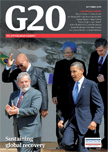

 |
 |
|

The Sustainable Energy Contribution
By Nobuo Tanaka, executive director, International Energy Agency
To download a low-resolution pdf, click here. (Be patient! It's 7.7 MB.)
A strategy is needed to promote continuous investment and ensure international cooperation for the development of low carbon energy technologies.Current trends in energy supply and use are not sustainable. The findings of the 2008 World Energy Outlook published by the International Energy Agency (IEA) show that if policies do not change, primary energy demand will grow by almost 50 per cent by 2030, with a persistent dominance of fossil fuels – oil, gas and coal. Demand will come mainly from developing countries, mostly China and India, where continued growth and adoption of a modern consumer lifestyle will drive demand for more transport, cooling and heating. Growing fossil fuel consumption will drive up global carbon dioxide emissions, contributing to potentially catastrophic climate change.
The energy sector produces 60 per cent of global greenhouse gas emissions. It must be a key part of any strategy to reduce them. The world must change the path that it is now on. This will take an energy revolution, and low carbon energy technologies will be at its heart. Energy efficiency, many types of renewable energy, carbon capture and storage (CCS), nuclear power and new transport technologies will all require widespread deployment to reach the necessary greenhouse gas emission goals.
The Reference Scenario – which assumes that no new policies are introduced – in the 2008 World Energy Outlook sees annual global primary energy demand growing 1.6 per cent on average up to 2030, from 11,730 million tons of oil equivalent (Mtoe) to just over 17,010 Mtoe – an increase of 45 per cent in a little more than 20 years. China and India account for slightly above half of this increase. Non-members of the Organisation for Economic Co-operation and Development (OECD) as a whole account for 87 per cent, so their share of world primary energy demand will rise from 51 per cent to 62 per cent.
Unfettered growth in energy demand will clearly have serious consequences. Under the Reference Scenario, carbon dioxide emissions will rise 45 per cent by 2030, contributing, with other greenhouse gases, to an eventual average temperature increase of up to 6°C. Three quarters of the extra carbon dioxide will come from China, India and the Middle East, and as much as 97 per cent from non-OECD countries as a whole – although non-OECD per capita emissions will still be far lower on average than among OECD members. Only the European Union and Japan will see lower emissions in 2030 than today’s levels.
The energy sector has a relatively slow rate of capital replacement because of the long lifetimes of much of its infrastructure. More efficient technologies normally take many years to spread throughout. As a result, both the public and private sectors must accept the need for additional investment, as well as the potential costs of early capital retirement, in order to accelerate this process and deliver deep cuts in emissions.
The financial and economic crisis has had a severe impact on the energy sector, contributing to plunging investment. Unpredictable energy markets and highly volatile prices hinder the ability of producers to plan and realise investment in new energy infrastructure. IEA calculations show that global investment in upstream oil and gas has already been cut by 21 per cent this year compared to 2008 – a reduction of about $100 billion. Governments must increase their spending and make a long-term commitment that extends well beyond the current crisis to support projects that address energy efficiency and low-carbon technology.
Enormous investment will be required to transform energy use, including significant changes in the pattern of investment across the supply and demand chains, as well as huge additional spending on new capital stock, especially in power plants and in more energy-efficient equipment and appliances. Although the sheer scale of the transformation means placing a substantial burden on both the public and private sectors, the current financial crisis should be used as an opportunity rather than a barrier for launching this process.
Sound energy investment strategies should be at the heart of every economic stimulus package. Governments must ensure that stimulus packages consist of green elements sufficient to prevent dangerous climate change. The IEA has calculated that of the total $2.6 trillion of public spending in short-term economic stimulus packages announced to date, $10 billion has been directed at energy efficiency and clean energy. This is a step in the right direction.
But much more needs to be done: investment in energy efficiency and clean technologies would need to increase four-fold to contain the rise in global average temperature (see figure in pdf or printed version). Limiting the temperature increase to around 2°C means that carbon dioxide emissions will need to be reduced by at least 50 per cent by 2050, in line with stabilising them at around 450 parts per million – a goal that G8 leaders are willing to achieve. To realise this scenario, the IEA has found that emissions would need to drop from 41 gigatonnes (Gt) in 2030 to 26 Gt, representing a reduction of 15 Gt. The bulk of this emissions reduction – 54 per cent – would need to come from energy efficiency, followed by more renewable energy and nuclear power and, eventually, CCS after 2020.
Against this background, the IEA urges the G20 to focus on energy savings and to support ongoing work on identification and dissemination of best practices, standards and recommendations for increasing energy efficiency. The IEA will host the secretariat of the newly launched International Partnership for Energy Efficiency Cooperation, a milestone in international cooperation on energy efficiency policy. The IEA welcomes the fact that the partnership has been called upon to take into account the IEA’s consolidated set of 25 efficiency recommendations to the G8. If all IEA recommendations were implemented globally, around 8.2 Gt of carbon dioxide per year could be saved by 2030. This is more than the current energy-related emissions of Japan and the United States combined.
Efficient markets, including carbon markets, are central to reducing emissions. They highlight the role of sectoral approaches, which are intended to address sectors that require urgent action, without waiting for countries to take nation-wide commitments. Calling for enhanced technology development and research to mitigate climate change, the IEA has undertaken an initiative to develop roadmaps for new energy technologies. It is currently working on 19 roadmaps for solar photovoltaic, wind, electric/hybrid vehicles, CCS, nuclear power and the cement industry. The goal is to create a global platform on low carbon energy technology and ultimately create an international strategy to promote continuous investment and ensure the widest international cooperation for accelerating the development and deployment of low carbon energy technologies. This approach was endorsed by the G8 leaders at the L’Aquila Summit in July 2009.
However, policymakers need to take a holistic approach when they consider investments in new technologies. They should consider the impact of their investment on the whole energy system and choose to invest first in technologies that are compatible with the existing system or will enable the development or deployment of other technologies. For example, investing in smart electricity grids will enable the more rapid spread of renewables and electric vehicles. Investing in CCS could help prolong the life of existing power plants, which might be cheaper than replacing them – especially to avoid locking in sub-optimal alternative technologies for an extended period.
|
This Information System is provided by the University of Toronto Library |
All contents copyright © 2023. University of Toronto unless otherwise stated. All rights reserved.